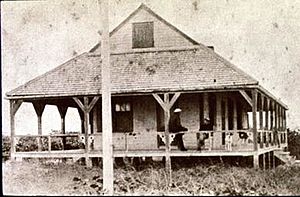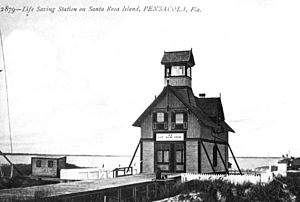Houses of Refuge in Florida facts for kids
The Houses of Refuge in Florida were special stations built along the coast of Florida. They were run by the United States Life-Saving Service, a group whose job was to rescue and help sailors whose ships had crashed. These houses gave shipwrecked sailors a safe place to stay, food, and fresh water.
Five of these houses were built on Florida's east coast in 1876. Then, five more were added in 1885 and 1886. There were also two "life-saving stations" built, which were a bit different. One was near Jupiter Inlet, and the other was on the Gulf coast, on Santa Rosa Island near Pensacola, Florida.
People called "keepers" lived in these houses with their families. They were in charge of the station. Most of these houses stayed open until 1915 or even later. After 1915, the Life-Saving Service joined with another group to form the United States Coast Guard. Some of the old Houses of Refuge then became Coast Guard stations.
Contents
Why Were They Built?
Before 1871, saving people from shipwrecks in the United States was mostly done by volunteers. But in 1871, the U.S. government decided to create a special service to do this, which became the United States Life Saving Service in 1878.
In the 1870s, much of Florida's east coast was very wild and empty. If a ship crashed there, sailors would have no way to find food, water, or shelter. There were only a few lighthouses and small settlements.
A big reason these houses were built in Florida was because of a shipwreck in October 1873. A ship crashed near what is now Fort Lauderdale, Florida during a hurricane. The sailors couldn't find any food or water. When they were finally found days later, they were starving and had only dirty water to drink. News of this spread, and Sumner Increase Kimball, who led the Revenue Marine Service, ordered five Houses of Refuge to be built in Florida. The government approved money for these houses in 1874, and then for five more in 1882.
How They Were Built and What They Had
These houses were made from strong Florida pine wood. They were designed to survive hurricanes, though a few were later destroyed by storms. Each house had a covered porch, called a veranda, all around it.
The main floor had four rooms: a kitchen with a fireplace, a dining room, a living room, and a bedroom. The station keeper and their family lived on this floor.
Upstairs, in the attic, was a dormitory for shipwrecked sailors. It had 20 beds with blankets, and enough dried and salted food to feed 20 men for 10 days. There were also chests of medicines and books. Clothes were stored for the sailors too, though sometimes they were too heavy for Florida's warm weather!
A brick cistern collected rainwater from the roof for drinking. A separate building held two lifeboats, special rescue gear called a breeches buoy, and flares for signaling. It's important to know that these houses were mostly meant as safe places for sailors who made it to shore, not as active rescue stations that would go out into the rough seas.
How They Operated
The keepers of the Houses of Refuge were paid workers. They were expected to live at the station with their families. This helped with the daily tasks and made the isolated locations less lonely.
Keepers had to live at the station all year round. They kept a daily log of the weather and counted how many ships passed by. After a storm, the keepers and their families had to search the beach for shipwrecks and any people who had been washed ashore.
Where Were They Located?
The first five Houses of Refuge, built in 1876, were along Florida's southeastern coast. People often called them by their numbers.
- Gilbert's Bar (House of Refuge No. 2) is a special one. It's near Stuart, Florida, and it's the only original House of Refuge still standing in Florida! It was open from 1876 and later became a Coast Guard station. Today, it's a museum run by the Historical Society of Martin County. You can visit it and learn more about its history.
- Orange Grove (House of Refuge No. 3) was in what is now Delray Beach, Florida. It was open from 1876 to 1896. It was named after a grove of sour orange trees nearby.
- Fort Lauderdale (House of Refuge No. 4) was near the old New River Inlet in Fort Lauderdale, Florida. It was open from 1876 until 1915. Sadly, the original building was destroyed by a big hurricane in 1926.
- Biscayne (House of Refuge No. 5) was on Miami Beach, Florida. It was also open from 1876 until 1915. Like the Fort Lauderdale house, it was badly damaged by the 1926 Miami hurricane.
Five more Houses of Refuge were built between 1885 and 1886, mostly north of the first ones:
- Smith's Creek (later called Bulow and Flagler Beach)
- Mosquito Lagoon
- Chester Shoal
- Cape Malabar
- Indian River Inlet
Life-Saving Stations
Besides the Houses of Refuge, there were also two "life-saving stations" in Florida. These stations were a bit different because they had a full crew of trained "surfmen" who were ready to go out in a lifeboat to rescue people, not just wait for them to come ashore.
- The Jupiter Inlet Life-Saving Station was near the Jupiter Inlet Lighthouse. It was open from 1886 to 1896. It had a keeper and a crew of six surfmen during the winter.
- The Santa Rosa Life-Saving Station was on Santa Rosa Island near Fort Pickens and the Pensacola Light. It was open from 1885 until 1915, and then became a Coast Guard station until 1986. The original building was destroyed by a hurricane in 1906 but was rebuilt in 1907. Today, this rebuilt building is used as a ranger station in Gulf Islands National Seashore.




